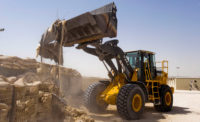Machines Are Adding Bulk
Newer models of construction equipment tend to have better operator visibility than older models—evidence that manufacturers may be utilizing the ISO standard test method as a design constraint as they develop new products. But many new machines come with added problems.
For one, visibility has become a moving target as deadlines approach for national air-quality standards, according to Michael Pankonin, senior director of technical and safety services for the Association of Equipment Manufacturers. By 2015, most off-road diesel machines will have to meet stringent Environmental Protection Agency “Tier 4” emission standards, requiring added components.
Scrubbers, such as selective catalytic reduction devices, are larger than conventional mufflers, and as a result “they'll take up a lot more real estate on or under the hood and significantly change the machine's profile,” Pankonin says.
To help operators get a clear view of the areas behind them, many manufacturers are augmenting mirrors with rear-view cameras, ultrasonic proximity sensors, radio-frequency identification systems and other sensors. While research on the effectiveness of these technologies is ongoing, Pankonin says the high incidence of false alarms from proximity sensors limits their widespread utility.
Ruggedness is an issue. “We're still learning how well these technologies will stand up in the harsh conditions of construction sites,” Pankonin says.
For now, NIOSH recommends combining a proximity warning device with a rear-view camera. “The warning device will prompt the operator to check the video monitor and see what is causing the alarm,” Fosbroke explains.
Anyone can view and download ">NIOSH's blind-area diagrams from its website, ">www.cdc.gov/niosh. The agency invites feedback from machinery buyers, users and safety professionals.
“We welcome input on how these diagrams might be used to promote awareness, and how to best get this information to the jobsite,” Fosbroke says.



Post a comment to this article
Report Abusive Comment